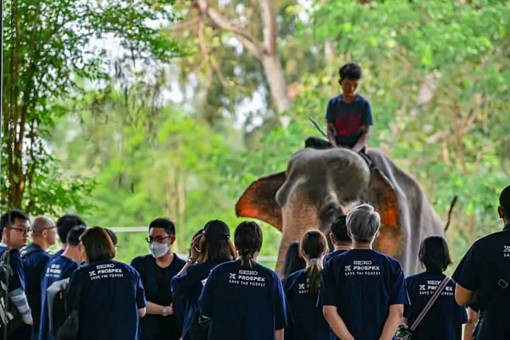A significant step to preserve and conserve wildlife started in the Western Forest Complex over two decades ago

Thailand’s Western Forest Complex is regarded as the largest wildlife hub in the country. It contains an abundant food chain system for predators and prey alike and is also home to several protected species, including the elephant, an enduring symbol of the nation.
March 13 was Thai National Elephant Day. The commemoration was first suggested by the Asian Elephant Foundation of Thailand and submitted to the Coordinating Subcommittee for the Conservation of Thai Elephants in 1998. However, according to the Royal Forest Department, the animal has, over the past decades, been facing various threats that have led to a decline in its population.
A significant step in the country’s wildlife conservation and preservation began here in the Western Forest Complex, particularly in Kanchanaburi, where the land was dominated by thick forests and abundant wildlife.
However, after World War II, wildlife hunting became popular among the people, especially those who were well-off. Many modern weapons from the war that were left behind were used to kill wild animals just for entertainment. This form of recreation quickly led to the number of wildlife decreasing.
A change was ignited by doctor-turned-conservationist Boonsong Lekagul, who demanded action to take back the forest and conserve and protect wildlife.
He is most remembered for presenting a stuffed head of an extinct Schomburg’s deer at Government House in the 1960s. The animal, shot dead in Kanchanaburi province in 1932, was the last of its kind in the country.
The military-led government at the time announced the Salakpra area in Kanchanaburi would become the country’s first wildlife sanctuary in 1965, covering 536,594 rai.
As part of the Salak Phra Wildlife Sanctuary, the Khao Nam Phu Nature and Wildlife Education Center in Si Sawat district houses the country’s most significant wildlife learning centre. The area is also a habitat for tigers, elephants and bantengs.
Seree Nakhon, chief of the Khao Nam Phu Nature and Wildlife Education Center, said tigers are a perfect indicator of forest fertility, and the centre plans to breed more bantengs while continuing to study tigers and elephants for better forest management.
The Japanese wristwatch company Seiko is a supporter of nature conservation. Its “Save the Forest to Save Our Elephants” has been running for seven years, aiming to raise public awareness of Thai elephant conservation and forest habitat.
To mark Thai Elephant Day, Grand Seiko managing director Akira Sakairi last month affirmed the company’s ambition to protect and preserve nature. Any change and loss of both marine and mainland ecological systems will harm people, he said.
The forest is a timeless treasure that needs generation-to-generation action for protection and conservation, he said.
The global community, he said, now faces a huge threat from climate change, and strong action from all stakeholders is needed to limit its impacts. Thus, a sustainable effort to preserve the forest and wildlife has become the company’s significant milestone to achieve.
“Various living things in the forest have incredibly shared connectivity,” he said. “All have different functions to create a balanced ecological system for the forest.”
“A loss from a tiny part could make a whole system fail,” he added. “So we have been doing our job to maintain the fragile system for running smoothly.”
The company recently hosted a media trip to the elephant hospital in Kasetsart University’s Kamphaeng Saen campus in Nakhon Pathom province. There, the company provided medical supplies for sick elephants.
The group also went to an elephant sanctuary in Saiyok subdistrict in Kanchanaburi’s Si Sawat district.
Alex Rendell, co-founder of the Environmental Education Centre and educator during the trip, said elephants have played a vital role in building up the forest as new trees could grow up from seeds in dung and its dung is also a nice place for bug incubation, increasing food source for birds.
“Elephant is a great contributor to forest fertility,” he said. “It also paves the way for smaller animals to access food more easily.”
“People have gained a lot of benefits from captive elephants, especially in the tourism industry. Caring for them and ensuring their good living condition is important.”

Seree Nakhon, chief of Khao Nam Phu Nature and Wildlife Education Center, explains the centre’s contributions and responsibilities to Seiko executives and the media.

